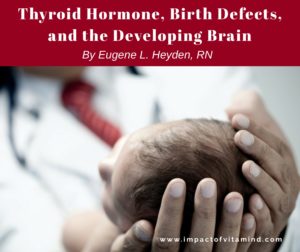Fatal Assumption (It’s about Babies. It’s about Iodine. It’s about Thyroid Hormone. It’s about Life Itself.)

Last update: 08-27-22
By Eugene L. Heyden, RN
Maybe you’ve had this experience: Losing a baby before birth, one who never made it into your loving arms, one lost forever. Perhaps this has happened to you more than once. Unfortunately, fetal loss occurs all too often. “It has been shown that 31% of pregnancies end in miscarriage, with two-thirds of the losses occurring before clinical detection.” (Sarkar, 2012) This is a lot of loss. And a lot of this can easily be prevented.
Many (if not most) ladies who are pregnant, and those who may become pregnant at a moment’s notice, are so unaware that something as simple as iodine deficiency—common even in the good ol’ USA—is a major cause of death before birth. The primary reason why iodine deficiency is so destructive is this: Iodine deficiency has a negative effect on the thyroid hormone status of the mother-to-be. I can’t even begin to tell you how destructive this is. I hope you will listen carefully.
It is not as if a normal thyroid hormone status during pregnancy is optional.
“Normal maternal thyroid function during pregnancy is critical for fetal development. Deficient maternal thyroid hormone levels during pregnancy are associated with impaired neuropsychological development in childhood, premature birth, preeclampsia, and fetal mortality.” (Burman, 2009, emphasis added)
“Development of maternal thyroid disorders during early pregnancy can influence the pregnancy outcome and fetal development. Thyroid dysfunction can lead to premature birth, pregnancy-induced hypertension [high blood pressure], increased fetal mortality, and low infant birth weight.” (Wang et al., 2011, emphasis added)
You’re reading carefully, right? Now read this carefully:
“Even minimal hypothyroidism can increase rates of miscarriage and fetal death and may also have adverse effects on later cognitive development of the offspring.” (Sarkar, 2012, emphasis added)
Now back to iodine for a minute or two, then we will tie things all together.
The idea that you could lose your baby simply because you have iodine deficiency may be new to you. Iodine is barely mentioned in the typical pregnancy book. It may get a paragraph, and if you’re lucky, perhaps a paragraph or two. I have a popular pregnancy book sitting on my bookshelf that makes no mention of iodine at all. Yet, the iodine status of the mother has the power to determine if the unborn baby lives or dies, and if he or she will turn out normal. This is so important that an entire book should be written about iodine, thyroid hormone, and fetal development. I think someone did this. I think it was me. I needed to get your attention—everybody’s attention! So much damage. So much loss. And iodine deficient mothers-to-be are everywhere!
“About one-third of pregnant women in the United States are iodine-deficient . . .. Currently, only about 15 percent of pregnant and breast-feeding women take supplements containing iodide, the researchers said.” (WebMD, 2014, emphasis added)
There are many reasons why so many are so iodine deficient. Iodized salt loses much of its iodine over time. Many prepared and fast foods—so heavily relied upon by many in their child-bearing years—are not made with iodized salt. Sea salt, in widespread use today, is not typically fortified with iodine. In the past, we used iodine-based dough conditioners in our baked goods. Those were the days when one slice of bread could supply as much a half of one’s daily requirement of iodine (Leung and Pearce, 2007). But not anymore. Today, we use bromide-based dough conditioners. Uh-oh! As it turns out, bromide compounds become “particularly significant in circumstances of a moderate iodine deficiency when they can interfere with the production of thyroid hormone.” (Pavelka, 2004) “As a consequence of these cumulative trends, US iodine stores dropped by 50% from 1970s levels . . ..” (Lockwood, 2013, emphasis added) Unfortunately, there is a price to be paid. Sometimes the ultimate price is paid. Some little someone is lost forever. Are you alarmed, yet? If not, I’ll try harder.
As previously mentioned, iodine deficiency has a negative effect on the thyroid hormone status of the mother-to-be. Iodine deficiency creates a subtle form of hypothyroidism, not affecting the mother, but affecting the baby. This unique form of hypothyroidism is called hypothyroxinemia. Maternal hypo-thyroxinemia is not benign. It is a killer. It kills unborn babies. It harms in other ways, too. Autism, attention-deficit/hyperactivity disorder, and learning disability quickly come to mind.
“Maternal hypothyroxinemia is an asymptomatic condition for the mother, but it is extremely harmful for the fetus. Because the fetus’s thyroid is still too immature to synthesize sufficient T3 and T4, the fetus relies on the maternal thyroid hormone for its optimal brain development.” (Opazo et al., 2008, emphasis added)
And this is so important: It is iodine deficiency that typically creates hypothyroxinemia. The condition is “asymptomatic,” so Mom feels great (except for the fact that she may feel like crap for other reasons). There is no symptom to look for, no symptom to report. It occurs silently, it destroys silently, and it is so preventable.
“Most cases of maternal hypothyroxinemia are related to a relative iodine deficiency during pregnancy that can be so easily prevented, with minimal expense, without risk and with worldwide success.” (Morreale de Escobar et al., 2004, emphasis added)
You have probably never heard of hypothyroxinemia before now. You should have. As a mother-to-be, you should be living in fear of it. Hypothyroxinemia during pregnancy basically means that the mother is producing insufficient amounts of the thyroid hormone T4 (thyroxin) to adequately meet the needs of the baby who is developing inside. Since maternal T4 is required to initiate and sustain the genetic events required for proper fetal development, a deficiency of maternal T4 allows developmental errors to occur, some obviously incompatible with life, many incompatible with normal life.
Unfortunately, in our society we make little effort to identify hypo-thyroxinemia in those who are pregnant or in those who seek preconception screening. The assumption is made that screening for maternal hypothyroidism, with the lab test called a TSH, is sufficient to identify those whose babies are at risk of an adverse outcome associated with a deficiency of thyroid hormone. This is a fatal assumption. The TSH is a great screening tool, but it is simply not enough. The TSH will never reveal hypothyroxinemia. In this condition, the TSH is normal. And to make matters worse, a normal TSH result typically stops further investigation into the thyroid hormone status of the mother-to-be. In this manner, the evil created by iodine deficiency, hypothyroxinemia, goes unnoticed. A normal TSH has the power to deceive.
“In the case of mild to moderate iodine deficiency during the pregnancy, the circulating T3 levels remain normal or even increase slightly and circulating TSH levels do not increase. So, the thyroid function tests may misleadingly indicate euthyroidism [normal thyroid status], while the amount of T4 available for the fetus might be insufficient.” (Klubo-Gwiezdzinska et al., 2011, emphasis added)
I hate to point out the obvious, but I will. And I will be bold! What follows is particularly directed at the physician: If you do not intentionally look for hypothyroxinemia in the mother-to-be, you won’t know that it exists. And if you don’t know that it exists, you will be so unaware that iodine deficiency has created a form of hypothyroidism that could seriously harm the baby who is under your care. It really is that simple. Perhaps you should stop waiting for others in your profession to climb on board and practice a little “universal screening” on your own. At least allow the informed patient to receive the thyroid function tests she requests and take it from there.
“While the incidence of hypothyroidism in pregnant women is around 2.5%, hypothyroxinemia is much more prevalent, up to 30%, and it is usually due to mild iodine deficiency.” (Bernal, 2014, emphasis added)
Now back to you, the mother-to-be. As you can see, hypothyroxinemia is not rare. It is easy to come by. And it is a real threat. It is a threat to a life, a threat to a normal outcome. Clearly, action needs to be taken.
“Efforts to detect and prevent maternal hypothyroxinemia in early pregnancy appear fully justified. Indeed, neurodevelopment defects, including an increased probability of cerebral palsy, may be 150 times more frequent than those resulting from untreated congenital hypothyroidism.” (Calvo et al., 2002, emphasis added)
What drives me crazy is that hypothyroxinemia is so easy to detect. With a simple test called a free T4 (fT4), or with a related test called a total T4, hypo-thyroxinemia can be identified. Once identified, treatment can follow, lives can be saved, abnormal outcomes can be prevented.
Until universal screening of all thyroid hormone abnormalities becomes a reality, it’s up to you, Mom, to do the best you can for your baby. You can make sure your prenatal vitamin contains the recommended 300 mcg of iodine per tablet. Then, in addition to a screening TSH at your first doctors’ visit, ask (insist) that a fT4 or a total T4 level be drawn to rule out hypothyroxinemia. If you feel like pushing the envelope, ask to be tested for anti-thyroid antibodies. These can harm your baby, too. If any thyroid abnormality is found, perhaps the best path to take is to enlist the services of a specialist, one who clearly understands the issues involved.
“Pregnant women with thyroid disease should be diagnosed and the treatment managed preferably in multidisciplinary clinics, where obstetricians, endocrinologists, pediatricians and other healthcare professionals can jointly work together to reduce risks of adverse pregnancy and neonatal outcomes associated with thyroid disease.” (Männistö, 2013)
In closing: A mother can rely on chance that all will work out okay. But I wouldn’t. Look around. Fetal loss is so common and damaged babies are everywhere! Babies are lost and babies are damaged from things that are so easy to prevent. Hypothyroxinemia serves as an example. To the medical profession: Look for it! Find it! Fix it! Is this too much to ask? To the mother who wants the best Medicine can offer: Insist that testing for hypothyroxinemia be performed as early as possible in the pregnancy (or before), and, if indicated, corrective action be taken. Why place your baby at unnecessary risk?
Related Posts (Click on image to open)
References
Allan WC, Haddow JE, Palomaki GE, Williams JR, Mitchell ML, Hermos JR, Faix JD, Klein RZ 2000 Maternal Thyroid Deficiency and Pregnancy Complications: Implications for Population Screening. J Med Screen 7:127–130
Berbel P, Nestre JL, Santamaría AM, Palazón I, Franco A, Graells M, González-Torga A, Morreale de Escobar G 2009 Delayed Neurobehavioral Development in Children Born to Pregnant Women with Mild Hypothyroxinemia during the First Month of Gestation: The Importance of Early Iodine Supplementation. Thyroid 19(5):511–519
Bernal J 2014 Thyroid Hormones in Brain Development and Function. Thyroid Disease Manager; Last update December 17, 2012
Burman KD 2009 Controversies Surrounding Pregnancy, Maternal Thyroid Status, and Fetal Outcome. Thyroid 19(4):323–326
Calvo RM, Jauniaux E, Gulbis B, Asunción M, Gervy C, Contempré B, Morreale de Escobar G 2002 Fetal Tissues are Exposed to Biologically Relevant Free Thyroxine Concentrations during Early Phases of Development. The Journal of Clinical Endocrinology & Metabolism 87(4):1768–1777
Feldt-Rasmussen R, Mortensen A-S B, Rasmussen AK, Boas M, Hilsted L, Main K 2011 Challenges in Interpretation of Thyroid Function Tests in Pregnant Women with Autoimmune Thyroid Disease. Journal of Thyroid Research Aritcle ID 598712 doi:10.4061/2011/589712
Klubo-Gwiezdzinska J, Burman KD, Van Nostrand D, Wartofsky L 2011 Levothyroxin Treatment in Pregnancy: Indications, Efficacy, and Therapeutic Regimen. Journal of Thyroid Research doi:10.4061/2011/843591
Leung AM, Pearce EN 2007 Iodine Nutrition in North America. Hot Thyroidology (www.hotthyroidology.com); September; 5
Mitchell ML, Klein RZ 2004 The Sequelae of Untreated Maternal Hypothyroidism. European Journal of Endocrinology 151:U45–U48
Opazo MC, Gianini A, Pancetti F, Azkcona G, Alarcón L, Lizana R, Noches V, et al 2008 Maternal Hypothyroxinemia Impairs Spatial Learning and Synaptic Nature and Function in the Offspring. Endocrinology 149:5097–5197
Pavelka S 2004 Metabolism of Bromide and Its Interference with the Metabolism of Iodine. Physiological Research; Jan 1; 53:S81–90
Sarkar D 2012 Recurrent Pregnancy Loss in Patients with Thyroid Dysfunction. Indian J Endocrinol Metab; Dec, 16; (Suppl 2):S350–S351
Wang W, Teng W, Shan Z, Wang S, Li J, Zhu L, Zhou J, et al 2011 The Prevalence of Thyroid Disorders during Early Pregnancy in China: The Benefits of Universal Screening in the First Trimester of Pregnancy. European Journal of Endocrinology 164:263–268
WebMD 2014 Iodine Deficiency Common in Pregnancy, Docs Warn. May 26; http://www.webmd.com/baby/news/20140526/iodine-deficiency-common-in-pregnancy-pediatricians-warn#1
Yu X, Chen Y, Shan Z, Teng W, Li C, Zhou W, Gao B, et al 2013 The Pattern of Thyroid Function of Subclinical Hypothyroid Women with Levothyroxine Treatment during Pregnancy. Endocrine 44:710–715
Disclaimer: This article is presented solely for informational purposes. The information contained herein should be evaluated for accuracy and validity in the context of opposing data, new information, and the views and recommendations of a qualified health care professional, and is not to be substituted for professional judgment and guidance or to provide reason to neglect or delay appropriate medical care. It is the reader and reader only who bears the responsibility for any actions that could be construed as being a response to the information contained herein. The statements and opinions expressed by the author have not been reviewed or approved by the FDA or by any other authoritative body, nor is the author endorsing any product or specific therapy. This article is offered to the reader to broaden his or her understanding of the issues discussed and to help identify options that may be suitable for the individual to pursue, on behalf of self or others, under approval and direction of a qualified physician. The author and publisher offer no guarantees of the accuracy or validity of the quotations incorporated into this article or the accuracy or validity of the information presented by the references used in this article.
Copyright © 2017–2022 Eugene L. Heyden, RN
All Rights Reserved



